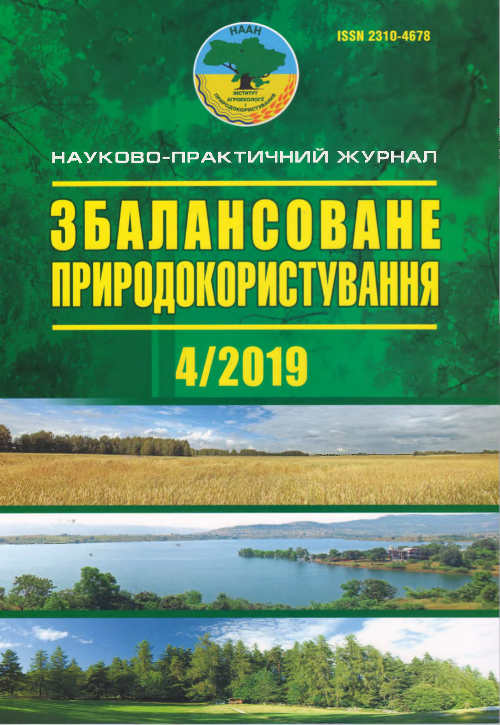ECOLOGICAL AND ECONOMIC ESTIMATION OF THE ARTIFICIAL CLIMATE OBJECTS FOR WINTER GRAINS FROST HARDNESS
DOI:
https://doi.org/10.33730/2310-4678.4.2019.199080Keywords:
ecological and economic assessment, artificial climate chambers, winter cereals, frost and winter hardiness, extreme natural conditionsAbstract
To have the selective practice under the conditions of different climatic changes and economic crisis it has appeared possible to use the estimation methods which correspond in particular to the before winter conditions. The selection of winter grains with the highest frost and winter hardness should be estimated under these conditions. Based on the long-term work on studying the problem of winter grains frost and winter hardness especially during the last 10 years it has been stated that the results determination of selection material frost hardness in the seeding boxes which are harden in natural conditions is doubtful due to daytime and nighttime temperature changes as well as to thaw and frost, that is why the given method of plant estimation on its frost hardness should be considered as supplementary.Sudden climatic changes contributes to it. Plant hardening under the nature extreme conditions ( soil bathes ones ) hard are more essential as compared to the fields ones. We managed to connect this year agrometeorological factors as well as to estimate and select frost-winter hardness plants as compared to the increased spike yielding. The study aimed at ecologic progeny testing under the natural provocative conditions (soil bathes) based on the studying of 111 strains of frost-winter hardness plants have been carried on. The purpose of the research was to get the plant off-springs which survived in the winter. To make winter wheat wintering more complicated we used special plastic cylinders which were placed on the soil bathes. The temperature changes are essential in such cylinders as in daytime the soil warming is better as compared to the one in the nighttime. The organic combination of the artificial climate conditions, the extreme nature temperature backgrounds with the fields ones,contribute to the ecological and economic efficient estimation as well as to plant selection, the off-springs of which can be the final selective material in new frost and winter hardness sort selecting. It makes it possible for the selectionist to estimate a great number of selective material due to its frost hardness level in the selection process primary portions as well as to differentiate the sorts according their characteristics. Also, it allows to fulfil the plant selection process with its further off-springs effectiveness.
References
Gorlach A.A. Methods of fields researches under the winter wheat selection on its winter hardness // Herald of agricultural sciences. — 1961. — № 9. — P. 37–40.
Dybovy V.I. Vernalization of winter wheat in rolls as an energy conserving element of its growing phytothronic technology // Selection and seed growing. — 1993. — № 4. — P. 36–39.
Dyshko N. V., Dybovy V. I., Myzuka V. N. The economic efficiency of the artificial climate objects usage: The collection of scientific works. MSRAE. — Myroniv, 1990. — P 179–182.
Korovin A.I., Basergina N. L., Kozlov G.I.and others. The effects of autumn warming of the winter wheat hardness as to the frost penetration // Scientific and technical bulletin VIR. — Issue. 116. — L., 1982. — P. 32–35.
Korovin A.I., Kalinin N. I., Kozlov G. I. and others. Modelling of the meteorological factors using technical means of agricultural strains estimation under the conditions of agrometeorological indices // Works on applied botany genetics and selection. — Volume. 66. — Issue. 1. —1980. — P. 8–16.
Lytvinenko M.A. The correlation of the universal type of winter wheat model because of climatic changes under the conditions of the south of Ukraine / M.A Lytvinenko // Herald of Bila Tserkva NAU. — 2008. — Issue. 52. — P. 18–25.
Mysuch V.N. The usage of the artificial climate in winter wheat selection on its frost hardness // Selection, seeds growing and intensive technology of winter wheat growing: The collection of scientific works. — M.: VO Agropromprinthouse, 1989. — P. 122–128.
Pasechnyk L.E., Pasov V.M., Matvieiva N.S. The agro climatic resources under the conditions of grain and grain-bean crops growing in the USA. Agrometeoprinthouse, 1989. — 270 p.
Saprygina E. S. The usage of the natural cold in winter seeds selection // Selection and seeds growin. 1940.— № 8–9. — P. 13–16.
Stelmah A.F. The peculiarities of winter wheat frost hardness changeability using the seeding boxes // Bulletin BCGI. — Odessa, 1973. — P. 14–16.
Downloads
Published
Issue
Section
License
- The authors reserve the right to authorship their work and pass the journal the right to publish this work under a Creative Commons Attribution License license, which allows other persons to freely distribute the published work with the obligatory The authors of the original work and the first publication of this magazine.
- The authors have the right to make independent additional agreements on the nonexclusive dissemination of the work in the form in which it was published by this magazine (for example, to post work in the company's electronic storage or to publish as a monograph) , subject to the first publication of the link to this journal.
- Journal policy allows and encourages the placement of authors on the Internet (for example, in the repositories of institutions or on personal websites) manuscript work as to the presentation of this manuscript to the editorial board and during its editorial processing, as it contributes to The productive scientific discussion and positively affects the efficiency and dynamics of citation published work (see The Effect of Open Access).


